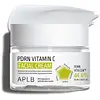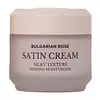What's inside
What's inside
 Key Ingredients
Key Ingredients

 Benefits
Benefits

 Concerns
Concerns

 Ingredients Side-by-side
Ingredients Side-by-side

Centella Asiatica Leaf Water
Skin ConditioningWater
Skin ConditioningGlycerin
HumectantCetyl Ethylhexanoate
EmollientButylene Glycol
HumectantPolyglyceryl-3 Methylglucose Distearate
Emulsifying1,2-Hexanediol
Skin ConditioningStearic Acid
CleansingSilica
AbrasiveGlyceryl Stearate
EmollientSodium Polyacryloyldimethyl Taurate
Emulsion StabilisingPropanediol
SolventBeeswax
Emulsion StabilisingHydroxyacetophenone
AntioxidantButyrospermum Parkii Butter
Skin ConditioningMacadamia Integrifolia Seed Oil
Skin ConditioningHydrogenated Polydecene
EmollientBetaine
HumectantTrehalose
HumectantCitric Acid
BufferingTrideceth-10
CleansingDisodium EDTA
Sodium Citrate
BufferingDipotassium Glycyrrhizate
HumectantAscorbic Acid
AntioxidantDipropylene Glycol
HumectantSqualane
EmollientAsiaticoside
AntioxidantMadecassic Acid
Skin ConditioningAsiatic Acid
Skin ConditioningSodium Hyaluronate
HumectantMelaleuca Alternifolia Leaf Extract
PerfumingHippophae Rhamnoides Fruit Extract
Skin ConditioningHydrolyzed Collagen
EmollientBeta-Glucan
Skin ConditioningCaprylyl Glycol
EmollientNelumbium Speciosum Flower Extract
Skin ConditioningArtemisia Annua Extract
MaskingOryza Sativa Extract
AbsorbentSaccharomyces Ferment
Skin ConditioningSolanum Melongena Fruit Extract
Skin ConditioningSodium Dna
Skin ConditioningCentella Asiatica Leaf Water, Water, Glycerin, Cetyl Ethylhexanoate, Butylene Glycol, Polyglyceryl-3 Methylglucose Distearate, 1,2-Hexanediol, Stearic Acid, Silica, Glyceryl Stearate, Sodium Polyacryloyldimethyl Taurate, Propanediol, Beeswax, Hydroxyacetophenone, Butyrospermum Parkii Butter, Macadamia Integrifolia Seed Oil, Hydrogenated Polydecene, Betaine, Trehalose, Citric Acid, Trideceth-10, Disodium EDTA, Sodium Citrate, Dipotassium Glycyrrhizate, Ascorbic Acid, Dipropylene Glycol, Squalane, Asiaticoside, Madecassic Acid, Asiatic Acid, Sodium Hyaluronate, Melaleuca Alternifolia Leaf Extract, Hippophae Rhamnoides Fruit Extract, Hydrolyzed Collagen, Beta-Glucan, Caprylyl Glycol, Nelumbium Speciosum Flower Extract, Artemisia Annua Extract, Oryza Sativa Extract, Saccharomyces Ferment, Solanum Melongena Fruit Extract, Sodium Dna
Water
Skin ConditioningGlycerin
HumectantPropanediol
SolventCaprylic/Capric Triglyceride
MaskingCetyl Ethylhexanoate
EmollientDimethicone
EmollientNiacinamide
SmoothingCyclopentasiloxane
EmollientButyrospermum Parkii Butter
Skin ConditioningPalmitic Acid
EmollientPolysorbate 60
EmulsifyingStearic Acid
CleansingSodium Polyacryloyldimethyl Taurate
Emulsion StabilisingSodium Acrylate/Sodium Acryloyldimethyl Taurate Copolymer
Emulsion StabilisingIsohexadecane
EmollientCI 77891
Cosmetic ColorantHydrogenated Polydecene
EmollientDimethiconol
EmollientSorbitan Stearate
EmulsifyingCaprylyl Glycol
EmollientChlorphenesin
AntimicrobialSodium Polyacrylate Starch
AbsorbentRosa Damascena Flower Water
MaskingPhenoxyethanol
PreservativePolysorbate 80
EmulsifyingDimethicone/Vinyl Dimethicone Crosspolymer
Skin ConditioningEthylhexylglycerin
Skin ConditioningButylene Glycol
HumectantSorbitan Oleate
EmulsifyingCitrus Aurantium Dulcis Peel Oil
MaskingTrideceth-10
CleansingAdenosine
Skin ConditioningPelargonium Graveolens Flower Oil
MaskingDisodium EDTA
Parfum
MaskingAluminum Hydroxide
EmollientMica
Cosmetic ColorantTriethoxycaprylylsilane
CI 77491
Cosmetic Colorant1,2-Hexanediol
Skin ConditioningCamellia Sinensis Leaf Extract
AntimicrobialSilica
AbrasiveCastanea Crenata Shell Extract
Skin ConditioningLavandula Angustifolia Flower Extract
CleansingVaccinium Macrocarpon Fruit Extract
AstringentTin Oxide
AbrasiveLactobionic Acid
BufferingPropylene Glycol
HumectantCrataegus Monogyna Flower Extract
Skin ConditioningHibiscus Sabdariffa Flower Extract
Skin ConditioningViola Tricolor Extract
EmollientAscorbic Acid
AntioxidantCitric Acid
BufferingMalic Acid
BufferingTartaric Acid
BufferingLimonene
PerfumingCitronellol
PerfumingGeraniol
PerfumingLinalool
PerfumingCitral
PerfumingWater, Glycerin, Propanediol, Caprylic/Capric Triglyceride, Cetyl Ethylhexanoate, Dimethicone, Niacinamide, Cyclopentasiloxane, Butyrospermum Parkii Butter, Palmitic Acid, Polysorbate 60, Stearic Acid, Sodium Polyacryloyldimethyl Taurate, Sodium Acrylate/Sodium Acryloyldimethyl Taurate Copolymer, Isohexadecane, CI 77891, Hydrogenated Polydecene, Dimethiconol, Sorbitan Stearate, Caprylyl Glycol, Chlorphenesin, Sodium Polyacrylate Starch, Rosa Damascena Flower Water, Phenoxyethanol, Polysorbate 80, Dimethicone/Vinyl Dimethicone Crosspolymer, Ethylhexylglycerin, Butylene Glycol, Sorbitan Oleate, Citrus Aurantium Dulcis Peel Oil, Trideceth-10, Adenosine, Pelargonium Graveolens Flower Oil, Disodium EDTA, Parfum, Aluminum Hydroxide, Mica, Triethoxycaprylylsilane, CI 77491, 1,2-Hexanediol, Camellia Sinensis Leaf Extract, Silica, Castanea Crenata Shell Extract, Lavandula Angustifolia Flower Extract, Vaccinium Macrocarpon Fruit Extract, Tin Oxide, Lactobionic Acid, Propylene Glycol, Crataegus Monogyna Flower Extract, Hibiscus Sabdariffa Flower Extract, Viola Tricolor Extract, Ascorbic Acid, Citric Acid, Malic Acid, Tartaric Acid, Limonene, Citronellol, Geraniol, Linalool, Citral
 Reviews
Reviews

Ingredients Explained
These ingredients are found in both products.
Ingredients higher up in an ingredient list are typically present in a larger amount.
1,2-Hexanediol is a synthetic liquid and another multi-functional powerhouse.
It is a:
- Humectant, drawing moisture into the skin
- Emollient, helping to soften skin
- Solvent, dispersing and stabilizing formulas
- Preservative booster, enhancing the antimicrobial activity of other preservatives
Ascorbic Acid is is pure Vitamin C. This form makes up the largest amount of vitamin C found naturally in our skin.
Not only is vitamin C great for your overall health and immune system, it also has plenty of benefits on your skin.
Vitamin C is best used for brightening skin. It improves dark spots, acne scars, and hyperpigmentation. This is because it blocks the process of skin darkening when exposed to UV.
Remember: Vitamin C should not replace sunscreen!
Your skin uses vitamin C to build collagen. Collagen is one key component in having a strong skin barrier and plump skin. Vitamin C also plays a role in regulating collagen, thus making it effective in improving wrinkles and fine lines.
Ascorbic acid shows potent antioxidant activity. As an antioxidant, it helps fight free-radicals. Free-radicals are molecules that may damage your skin cells. These antioxidants also protect skin against UV damage.
The best formulations include Vitamin E and/or ferulic acid. These two ingredients help stabilize and provide a boost in the benefits of ascorbic acid. This is because ascorbic acid becomes unstable when exposed to UV and air. In fact, you can tell your ascorbic acid has oxidized when it turns an orange-yellow color.
Ascorbic acid is generally compatible with other ingredients. However, using ascorbic acid with other active ingredients might cause irritation. Two ingredients: copper ions and benzoyl peroxide, will inactivate ascorbic acid completely.
Read more about other types of Vitamin C:
Foods rich with vitamin C include oranges, strawberries, broccoli, bell peppers, and more. When consuming Vitamin C, your skin receives a portion of the nutrients.
Learn more about Ascorbic AcidButylene Glycol (or BG) is used within cosmetic products for a few different reasons:
Overall, Butylene Glycol is a safe and well-rounded ingredient that works well with other ingredients.
Though this ingredient works well with most skin types, some people with sensitive skin may experience a reaction such as allergic rashes, closed comedones, or itchiness.
Learn more about Butylene GlycolThis ingredient is also known as shea butter. It is an effective skin hydrator and emollient.
Emollients help soothe and soften your skin. It does this by creating a protective film on your skin. This barrier helps trap moisture and keeps your skin hydrated. Emollients may be effective at treating dry or itchy skin.
Shea butter is rich in antioxidants. Antioxidants help fight free-radicals, or molecules that may harm the body. It is also full of fatty acids including stearic acid and linoleic acid. These acids help replenish the skin and keep skin moisturized.
While Shea Butter has an SPF rating of about 3-4, it is not a sunscreen replacement.
Shea butter may not be fungal acne safe. We recommend speaking with a professional if you have any concerns.
Learn more about Butyrospermum Parkii ButterCaprylyl Glycol is a humectant and emollient, meaning it attracts and preserves moisture.
It is a common ingredient in many products, especially those designed to hydrate skin. The primary benefits are retaining moisture, skin softening, and promoting a healthy skin barrier.
Though Caprylyl Glycol is an alcohol derived from fatty acids, it is not the kind that can dry out skin.
This ingredient is also used as a preservative to extend the life of products. It has slight antimicrobial properties.
Learn more about Caprylyl GlycolCetyl Ethylhexanoate is an emollient ester. It comes from cetearyl alcohol and 2-ethylhexanoic acid.
Cetyl Ethylhexanoate is an emollient that adds a velvety feel to skin without being greasy or oily. Emollients help trap moisture into your skin, keeping your skin soft and hydrated.
Citric Acid is an alpha hydroxy acid (AHA) naturally found in citrus fruits like oranges, lemons, and limes.
Like other AHAs, citric acid can exfoliate skin by breaking down the bonds that hold dead skin cells together. This helps reveal smoother and brighter skin underneath.
However, this exfoliating effect only happens at high concentrations (20%) which can be hard to find in cosmetic products.
Due to this, citric acid is usually included in small amounts as a pH adjuster. This helps keep products slightly more acidic and compatible with skin's natural pH.
In skincare formulas, citric acid can:
While it can provide some skin benefits, research shows lactic acid and glycolic acid are generally more effective and less irritating exfoliants.
Most citric acid used in skincare today is made by fermenting sugars (usually from molasses). This synthetic version is identical to the natural citrus form but easier to stabilize and use in formulations.
Read more about some other popular AHA's here:
Learn more about Citric AcidDisodium EDTA plays a role in making products more stable by aiding other preservatives.
It is a chelating agent, meaning it neutralizes metal ions that may be found in a product.
Disodium EDTA is a salt of edetic acid and is found to be safe in cosmetic ingredients.
Learn more about Disodium EDTAGlycerin is already naturally found in your skin. It helps moisturize and protect your skin.
A study from 2016 found glycerin to be more effective as a humectant than AHAs and hyaluronic acid.
As a humectant, it helps the skin stay hydrated by pulling moisture to your skin. The low molecular weight of glycerin allows it to pull moisture into the deeper layers of your skin.
Hydrated skin improves your skin barrier; Your skin barrier helps protect against irritants and bacteria.
Glycerin has also been found to have antimicrobial and antiviral properties. Due to these properties, glycerin is often used in wound and burn treatments.
In cosmetics, glycerin is usually derived from plants such as soybean or palm. However, it can also be sourced from animals, such as tallow or animal fat.
This ingredient is organic, colorless, odorless, and non-toxic.
Glycerin is the name for this ingredient in American English. British English uses Glycerol/Glycerine.
Learn more about GlycerinHydrogenated Polydecene is an emollient. It creates a non-occlusive film on the skin that offers extra protection for your skin barrier.
The texture of Hydrogenated Polydecene ranges from light and silky to rich.
Hydrogenated Polydecene is the end compound of controlled hydrogenation of Polydecene.
Learn more about Hydrogenated PolydecenePropanediol is an all-star ingredient. It softens, hydrates, and smooths the skin.
It’s often used to:
Propanediol is not likely to cause sensitivity and considered safe to use. It is derived from corn or petroleum with a clear color and no scent.
Learn more about PropanediolSilica, also known as silicon dioxide, is a naturally occurring mineral. It is used as a fine, spherical, and porous powder in cosmetics.
Though it has exfoliant properties, the function of silica varies depending on the product.
The unique structure of silica enhances the spreadability and adds smoothness, making it a great texture enhancer.
It is also used as an active carrier, emulsifier, and mattifier due to its ability to absorb excess oil.
In some products, tiny microneedles called spicules are made from silica or hydrolyzed sponge. When you rub them in, they lightly polish away dead skin layers and enhance the penetration of active ingredients.
Learn more about SilicaSodium Polyacryloyldimethyl Taurate is a polymer and used to help stabilize other ingredients.
Emulsion stabilizers hold ingredients together, helping to create an even texture throughout the product.
Sodium Polyacryloyldimethyl Taurate can also be used to thicken the texture.
Learn more about Sodium Polyacryloyldimethyl TaurateStearic Acid is a fatty acid. It is an emollient, emulsifier, and texture enhancer.
As an emollient, stearic acid helps soften skin. It aids the skin's protective barrier by preventing water loss. It also provides a gentle cleansing effect without stripping away natural oils.
Stearic acid may also be used to enhance the texture of products. It can add volume and stabilize ingredients such as water and oil. This can help water and oil ingredients from separating.
Sources of stearic acid include animal or vegetable fats/oils such as coconut or shea. It can be naturally found in butter, cocoa butter, shea butter, vegetable fats, and animal tallow.
This ingredient may not be Malassezia folliculitis, or fungal-acne safe.
Learn more about Stearic AcidWe don't have a description for Trideceth-10 yet.
Water. It's the most common cosmetic ingredient of all. You'll usually see it at the top of ingredient lists, meaning that it makes up the largest part of the product.
So why is it so popular? Water most often acts as a solvent - this means that it helps dissolve other ingredients into the formulation.
You'll also recognize water as that liquid we all need to stay alive. If you see this, drink a glass of water. Stay hydrated!
Learn more about Water